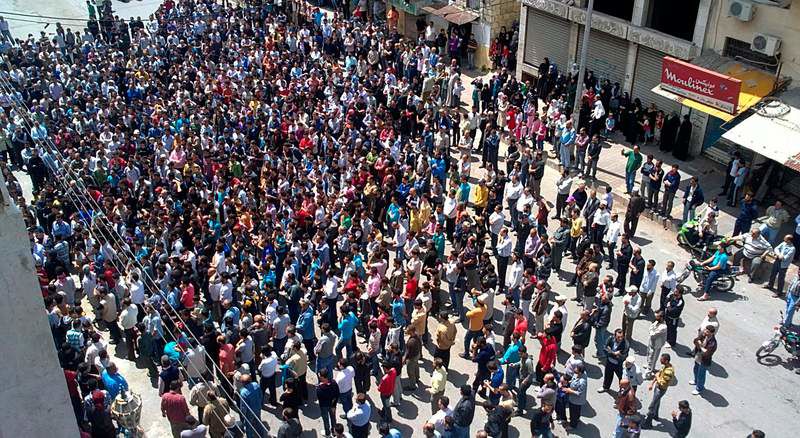Syrians defy crackdown, stage widespread protests
Published 5:00 am Saturday, May 7, 2011

- This mobile phone photo shows Syrian anti-government protesters gathering in the coastal town of Banias, Syria, on Friday. Syrian security forces opened fire on protesters Friday, killing at least 26.
BEIRUT — Syrian troops used heavy machine guns and artillery to quell anti-government demonstrations in the key city of Homs on Friday in a sharp escalation of their crackdown against regime opponents, as tens of thousands of Syrians again defied the threat of bullets and tanks to take to the streets around the country.
Witnesses reached by telephone in Homs on Friday evening said they could hear what appeared to be pitched battles in several neighborhoods, prompting speculation that some members of the security forces had defected.
Syrian state television reported that 10 members of the security forces had been killed in Homs by “armed gangs,” the term used by the government to describe the protesters. But there have been no indications that any members of the seemingly spontaneous and mostly leaderless protest movement are armed.
At least 26 people were killed when Syrian forces opened fire on demonstrators, with 11 deaths reported in Homs and six in the nearby town of Hama, said Wissam Tarif of the human rights group Insan.
The clashes in Homs came amid signs that Syrians have not been cowed by the hundreds of deaths and thousands of arrests carried out in recent weeks in an effort to suppress the biggest challenge to the regime since President Bashar al-Assad’s father put down an armed revolt in Hama in 1982.
That crackdown, in which as many as 40,000 people died, earned the Syrian regime a reputation as one of the most repressive in the Middle East, and when revolts began rippling around the region earlier in the year, many predicted that Syrians would not dare join the swelling clamor for change.
But although Syrians came relatively late to the game, with no significant protests reported until mid-March, their opposition movement seems only to have swelled in the face of the government’s increasingly brutal crackdown. Human rights groups say more than 500 people have been killed, most of them at demonstrations, and at least 5,000 arrested.
Friday marked the seventh week since protesters first took to the streets, initially in small numbers and to call only for reforms. But as the government has responded to the unrest with escalating force, so has the protest movement persisted and spread, and it now seems clear that much of the country is in open revolt against the regime.
Responding to calls by activists to stage a “day of defiance” to protest the security crackdown, people swarmed out of mosques after noontime prayers in dozens of locations around the country, many of them calling for the overthrow of the regime.
In Damascus, which has remained largely immune from the unrest, security forces detained veteran opposition activist Riad Seif as he emerged from a mosque. Security forces dispersed a small demonstration there Friday with tear gas and ammunition.
There was no indication that this week’s protests were any larger than those on the previous two Fridays, when troops also used live fire to disperse protesters. The death toll was also lower than it was on the past two Fridays.
That may have been because tanks and security forces blocked major roads, making it impossible for people to gather in large numbers in central locations, Tarif said. Instead, he said, they staged smaller protests in individual neighborhoods.
“What is amazing is that it is happening in so many towns and villages around the country,” he said.
Demonstrations were reported also in the northern coastal towns of Latakia and Baniyas, the predominantly Kurdish northeastern town of Qamishli, Abu Kamal on the Iraqi border and in several small villages around the besieged southern city of Daraa, where the protest movement started.
But it was in Homs that the violence was worst, and it appeared to intensify after nightfall. The government cut land lines to three neighborhoods in the city, several artillery shells had exploded and the sound of gunfire was “almost continuous,” according to a resident contacted by telephone, who spoke on the condition of anonymity out of concern for his safety.
“There is shooting in all districts of Homs,” he said, adding that it appeared the fighting was taking place between rival factions in the security forces.
A split in the security forces is the regime’s worst nightmare, given the role the army played in securing the downfall of the regimes in Egypt and Tunisia earlier in the year. But this is also not the first time that there have been indications of defections.
When the government sent tanks to suppress the uprising in Daraa nearly two weeks ago, there were numerous reports that some soldiers had been shot for refusing to fire on protesters.
The crackdown nonetheless proceeded, and it is feared that hundreds may have been killed and many more detained in the southern rural city, which has been besieged by troops for the past 12 days.
Most reports from Syria cannot be independently verified, because foreign journalists have been denied visas. Among the thousands detained in the crackdown is a journalist for the al-Jazeera network, Dorothy Parvez, an Iranian Canadian who was taken into custody after she flew into the country from Qatar last week.
Many Syrians say they have only been galvanized by the brutality, and in some areas troops have not moved to crush the demonstrators. In the town of Baniyas, ringed by tanks for more than a week, several thousand people demonstrated Friday carrying olive branches and roses, which they intended to give to the army should it enter, a student activist said. The troops stayed away.
“The tanks could come to crush us at any time,” said the protester, who asked that his name not be used for his safety. “But we are not afraid, and we will continue our protest.”






